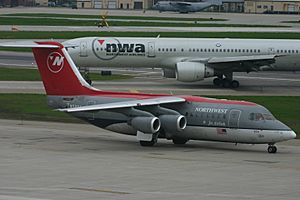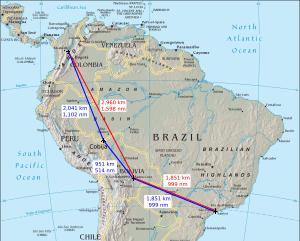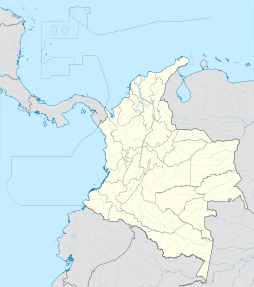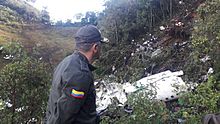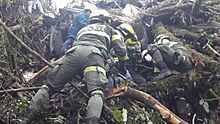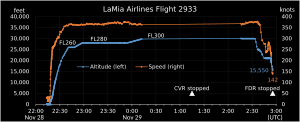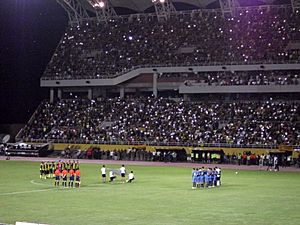LaMia Flight 2933 facts for kids

The Avro RJ85 involved, photographed in 2013 with its previous registration number
|
|
| Accident summary | |
|---|---|
| Date | 28 November 2016 |
| Summary | Crashed following fuel exhaustion |
| Place | Mt. Cerro Gordo, near La Unión, Antioquia, Colombia 5°58′43″N 75°25′6″W / 5.97861°N 75.41833°W |
| Passengers | 73 |
| Crew | 4 |
| Injuries (non-fatal) | 6 |
| Fatalities | 71 |
| Survivors | 6 |
| Aircraft type | Avro RJ85 |
| Airline/user | LaMia |
| Registration | CP-2933 |
| Flew from | Viru Viru International Airport, Santa Cruz de la Sierra, Bolivia |
| Flying to | José María Córdova International Airport, Rionegro, Colombia |
LaMia Flight 2933 was a special plane trip (a charter flight) that crashed on November 28, 2016. The plane, an Avro RJ85 operated by LaMia, was flying near Medellín, Colombia. Out of 77 people on board, 71 sadly died.
The aircraft was carrying the Brazilian football team, Chapecoense, and their group. They were flying from Santa Cruz de la Sierra, Bolivia, to Medellín. The team was going to play in the 2016 Copa Sudamericana Finals. Six people survived the crash: one crew member, three players, and two other passengers.
Investigators found that the plane crashed because it ran out of fuel. This happened due to a poorly planned flight by the airline. Also, the pilots made bad decisions as the situation got worse. They did not even tell air traffic control that they had an emergency. This meant they did not get a priority landing when they desperately needed one.
Contents
About the Plane and Airline
The Aircraft and Its Operator
The plane was an Avro RJ85 with the registration number CP-2933. It first flew on March 26, 1999. After being used by other airlines, it was bought by LaMia. LaMia was an airline from Venezuela that operated out of Bolivia.
The Crew
The captain was 36-year-old Miguel Quiroga. He used to be a pilot for the Bolivian Air Force. He joined LaMia in 2013 and was also one of the airline's owners. Captain Quiroga had flown for a total of 6,692 hours.
The first officer was 47-year-old Fernando Goytia. He was also a former pilot for the Bolivian Air Force. He had flown for 6,923 hours in total.
Another pilot, 29-year-old Sisy Arias, was in the cockpit for training. She was an observer during the flight.
The Flight and Crash
The plane was carrying 73 passengers and four crew members. They were flying from Viru Viru International Airport in Santa Cruz de la Sierra, Bolivia. Their destination was José María Córdova International Airport near Medellín, Colombia.
Among the passengers were 22 players from the Brazilian football club Associação Chapecoense de Futebol. There were also 23 staff members, 21 journalists, and two guests. The team was traveling to play in the final match of the 2016 Copa Sudamericana.
Journey to Bolivia
Chapecoense first wanted to hire LaMia for the entire trip from São Paulo to Medellín. However, Brazil's aviation agency said no. This was because of rules about international flights. So, the team flew with another airline to Santa Cruz, Bolivia. There, they boarded the LaMia flight. LaMia had flown other football teams before, including the Argentine national team.
Flight from Santa Cruz
LaMia flight 2933 left Santa Cruz at 6:18 PM local time. The departure was delayed because a team member needed a video game from his luggage. The original plan included a fuel stop in Cobija, Bolivia. But the flight left late, so they would not arrive before that airport closed.
An officer at Santa Cruz airport reportedly rejected the crew's flight plan several times. This was because the plane's range was almost the same as the flight distance. However, another officer later approved the plan. The distance between Santa Cruz and Medellín is about 1,598 nautical miles (2,959 km).
The crew expected to use about 8,858 kg of fuel for their trip. After refueling in Santa Cruz, the plane had 9,073 kg of fuel. However, aviation rules would have required them to carry 12,052 kg of fuel. This extra fuel is for holding patterns, diversions, or other unexpected events. The RJ85's fuel tanks can hold 9,362 kg.
Around 9:16 PM, about 180 nautical miles (330 km) from Medellín, the plane showed a low-fuel warning. At this point, they were 77 nautical miles (143 km) from Bogotá. But the crew did not try to land there or tell air traffic control about the problem. The plane kept flying towards Medellín and started to descend at 9:30 PM.
Another plane had been given priority to land in Medellín due to a suspected fuel leak. So, at 9:43 PM, the LaMia crew was told to wait in a holding pattern. They had to wait with three other planes for their turn to land. While waiting, the plane flew two laps in the holding pattern. This added about 54 nautical miles (100 km) to its flight.
At 9:49 PM, the crew asked for priority landing because of "problems with fuel." They were told to expect to land in about seven minutes. Minutes later, at 9:52 PM, they declared a fuel emergency and asked to descend immediately. At 9:53 PM, the plane's engines 3 and 4 (on the right wing) stopped working because they ran out of fuel. Engines 1 and 2 stopped two minutes later. At this point, the flight data recorder stopped working.
Just before 10:00 PM local time on November 28, the pilot reported an electrical failure and that they had run out of fuel. This happened while flying over Colombia. Air traffic control lost contact with the plane at 9:55 PM as it flew down among the mountains.
At 9:59 PM, the plane crashed into a mountain called Cerro Gordo. The wreckage was spread across the mountain.
Rescue Efforts
Heavy fog made it hard for helicopters to reach the crash site. First aid workers arrived two hours after the crash. They found pieces of the plane spread over a large area.
The first survivor, Alan Ruschel, a Chapecoense player, arrived at a hospital at 2:00 AM on November 29. Six people were found alive in the wreckage. The last survivor, footballer Neto, was found at 5:40 AM. Another player, Jakson Follmann, had a leg amputation that saved his life.
In total, 71 of the 77 people on board died. The number was first thought to be 75, but four people had not boarded the plane. Colombian Air Force workers took the bodies to an air force base. They were then taken to a special center in Medellín for identification.
The Investigation
Colombian Crash Investigation
Colombia's aviation agency, Aerocivil, started investigating the accident. They asked for help from BAE Systems (the company that made the plane) and the British Air Accidents Investigation Branch. Investigators from Bolivia, Brazil, and the United States also joined.
On November 29, Aerocivil announced that both flight recorders (the flight data recorder and cockpit voice recorder) were found undamaged.
It quickly became clear that the plane had run out of fuel. A flight attendant who survived said the captain's last words were "there is no fuel." Other pilots also heard the crew tell air traffic control about the fuel problem. The plane did not catch fire when it crashed, which also suggested it had no fuel. The flight data recorder showed all four engines stopped working a few minutes before the crash.
The investigation found that LaMia often flew its planes without enough fuel. They had been lucky to avoid delays that the required fuel was meant to cover. One report said the airline had broken fuel rules on 8 of its 23 previous flights. This meant the company was used to flying with very little extra fuel.
Final Report Findings
On April 27, 2018, the final report on the crash was released. It listed the main reasons for the accident:
- The airline planned the flight badly. They did not include enough fuel for emergencies, diversions, or even the minimum needed to land.
- All four engines stopped one by one because they ran out of fuel.
- LaMia employees made poor decisions. Their company processes did not ensure safety.
- The flight crew made bad decisions. They kept flying with very low fuel, even though they knew it was dangerous. They did not try to land the plane earlier to refuel.
Other things that contributed to the crash were:
- The landing gear was put down too early.
- Problems in how non-regular flights were planned and carried out, especially regarding fuel.
- LaMia did not supervise the flight planning or its execution. They also did not advise the crew.
- The crew did not ask for priority or declare an emergency when fuel was running out. These actions would have helped air traffic control.
- The airline did not follow the fuel rules approved by Bolivia's aviation authority.
- Delays in the plane's approach to the runway happened because the crew declared their emergency late. There was also heavy air traffic in the area.
Other Important Findings
The cockpit voice recorder (CVR) showed the pilots talking about their fuel and possible fuel stops. But they were so used to flying with minimal fuel that they decided not to stop. For some reason, the CVR stopped recording an hour and forty minutes before the crash. Investigators believe the captain, who also owned part of LaMia, might have turned off the CVR. He might have wanted to hide discussions about the low fuel.
The plane was also estimated to be nearly 400 kg (880 lb) overweight.
Reactions to the Crash
Government Responses
Bolivia's aviation authority stopped LaMia from flying and took control of its two remaining planes. The Bolivian government also suspended several aviation officials.
Brazil's President, Michel Temer, declared three days of national mourning. He asked for help for the survivors and victims' families.
Sports World Reactions

Many South American football teams honored Chapecoense. They changed their uniforms to include Chapecoense's badge or wore green colors. Football matches worldwide also began with a minute of silence.
CONMEBOL (South American Football Confederation)
All football activities by CONMEBOL were stopped. This included the Copa Sudamericana final matches. Atlético Nacional, the team Chapecoense was supposed to play, asked CONMEBOL to give the Copa Sudamericana title to Chapecoense. They said, "for our part, and forever, Chapecoense are champions."
CONMEBOL officially named Chapecoense the 2016 Copa Sudamericana champions on December 5. The Brazilian team received the winner's prize money. They also qualified for other important tournaments. Atlético Nacional received a special award for their sportsmanship.
FIFA (International Football Federation)
FIFA president Gianni Infantino spoke at a public memorial at Chapecoense's stadium. He said, "Today we are all Brazilians, we are all Chapecoenses." Nacional also received the FIFA Fair Play Award for their kind gesture.
UEFA (European Football Association)
UEFA asked for a minute of silence at all upcoming Champions League and Europa League matches. UEFA President Aleksander Ceferin said, "European football is united in expressing its deepest sympathy."
National Football Associations
The Argentine Football Association offered to loan players from Argentine clubs to Chapecoense for free.
The Brazilian Football Confederation (CBF) encouraged Chapecoense to play their next game as a tribute. However, both Chapecoense and their opponent refused to play. Other Brazilian teams offered to loan players and asked the CBF to protect Chapecoense from being moved down to a lower league for three years.
In Colombia, a four-hour tribute was held at Atlético Nacional's stadium. 40,000 fans attended.
The Uruguayan Football Association declared two days of mourning. Their referees wore a Chapecoense badge on their shirts.
Other Reactions
Avianca, Colombia's largest airline, provided psychologists to help the victims' families. They also helped transport Brazilian medical staff.
LaMia's insurance policy had ended before the crash because they had not paid. The policy also did not cover flights to Colombia. However, the insurers agreed to pay US$225,000 to each deceased passenger's family.
Roberto Canessa, a survivor of a 1972 plane crash in the Andes, offered to help the crash survivors.
Spanish football club FC Barcelona hosted Chapecoense for a friendly match on August 7, 2017. This was a fundraiser to help rebuild Chapecoense's team. Alan Ruschel, one of the surviving players, played in this game.
In the video game FIFA 17, players were given the Chapecoense emblem for free.
Survivors
The surviving players were Alan Ruschel, Jakson Follmann and Neto. The other survivors were a flight attendant and two passengers. One passenger said the pilots did not announce an emergency. He thought the plane was just descending before the crash.
Chapecoense goalkeeper Danilo was first reported to have survived but later died in the hospital. However, the hospital later clarified that he died in the crash itself.
Brazilian radio personality Rafael Henzel, the only journalist to survive, sadly died on March 26, 2019, from a heart attack.
Notable People Who Died
Chapecoense Players
- Ailton Cesar Junior Alves da Silva (Canela), 22
- Dener Assunção Braz (Dener), 25
- Marcelo Augusto Mathias da Silva (Marcelo), 25
- Matheus Bitencourt da Silva (Matheus Biteco), 21
- Mateus Lucena dos Santos (Caramelo), 22
- Guilherme Gimenez de Souza (Gimenez), 21
- Lucas Gomes da Silva (Lucas Gomes), 26
- Everton Kempes dos Santos Gonçalves (Kempes), 34
- Arthur Brasiliano Maia (Arthur Maia), 24
- Ananias Eloi Castro Monteiro (Ananias), 27
- Marcos Danilo Padilha (Danilo), 31
- Filipe José Machado (Filipe Machado), 32
- Sérgio Manoel Barbosa Santos (Sérgio Manuel), 27
- José Gildeixon Clemente de Paiva (Gil), 29
- Bruno Rangel Domingues (Bruno Rangel), 34
- Cléber Santana Loureiro (Cléber Santana), 35
- Josimar Rosado da Silva Tavares (Josimar), 30
- William Thiego de Jesus (Thiego), 30
- Tiago da Rocha Vieira Alves (Tiaguinho), 22
Chapecoense Staff
- Luiz Carlos Saroli (Caio Júnior), coach, 51
Media Members
- Mário Sérgio Pontes de Paiva, Fox Sports commentator, former national team player and manager, 66
- Paulo Julio Clement, Fox Sports, 51
- Victorino Chermont, Fox Sports, 43
Guests
- Delfim de Pádua Peixoto Filho (Delfim Peixoto), former vice-president of the Brazilian Football Confederation, 75
In Popular Culture
The US TV channel ESPN made an hour-long story about the crash for its E:60 news show. It focused on how one of the pilots was also a co-owner of the airline. It also showed the effects on the survivors and the families of those who died.
The crash of LaMia Flight 2933 was also featured in an episode of the Canadian TV documentary series Mayday. The episode was called "Football Tragedy" (or "Soccer Tragedy" in the US).
Images for kids
 In Spanish: Vuelo 2933 de LaMia para niños
In Spanish: Vuelo 2933 de LaMia para niños


